3DMark
3DMark is a multi-platform hardware benchmark designed to test varying resolutions and detail levels of 3D gaming performance. We run the Windows platform test and in particular the Fire Strike benchmark, which is indicative of high-end 1080p PC Gaming. We also test using the Time Spy benchmark which gives an indication of DirectX 12 performance.
The ability of Fire Strike to leverage a high thread count in its Physics test shoot the BDW-E 6800K to the top of the performance chart, beating out the overclocked 7700K. As is the trend, Kaby Lake is faster than Skylake only due to its higher clock speeds.
Worth noting is the 4.8GHz 7700K's ability to outperform a 4.7GHz 4790K by more than 2000 points (17%). A similar margin is observed at stock speeds. But of course, this test is not entirely representative of real-world gaming performance.
Time Spy narrows the gap to the 12-thread 6800K. Skylake architecture and a high clock speed (as seen in Kaby Lake) put in good performance showings. A 4.9GHz Core i5-7600K is right on the heels of the Core i7-4790K.
VRMark
The recently-released VRMark benchmark aims to score systems based on their VR performance potential by using rendering resolutions associated with VR devices of today and the future. We test using the Orange Room benchmark which uses a rendering resolution of 2264×1348 to analyse the capability of hardware with current devices such as the HTC Vive and Oculus Rift.
VRMark is more of a system-wide test that also puts heavy load on the graphics card. As such, it is hard to draw conclusions from the results. However, Kaby Lake does consistently put in solid performance numbers that sit it near the top of the chart when overclocked.
Ashes of the Singularity
Ashes of the Singularity is a Sci-Fi real-time strategy game built for the PC platform. The game includes a built-in benchmark tool and was one of the first available DirectX 12 benchmarks. We run the CPU-focused benchmark using DirectX 12, a 1080p resolution and the Extreme quality preset.
DirectX 12 and a CPU-punishing benchmark tool make Ashes of the Singularity a good way of testing gaming performance offered by different processors. The Skylake-powered i7s congregate towards the top of the chart thanks to their high frequencies and fast microarchitecture. The overclocked Skylake-based i7s perform similarly to the overclocked 12-thread 6800K.
The 4.8GHz 7700K is 17% faster than a 4.7GHz 4790K. A similar performance difference is observed at stock speeds. Kaby Lake's i7-7700K outperforms the 3.6GHz 12-thread 6800K even when without overclocking. Four cores and no hyper-threading leave the i5s battling at the bottom of the chart. Higher speeds put the Kaby Lake 7600K in front of its Skylake 6600K predecessor. A 4.9GHz i5-7600K is not too far behind i7-4790K performance levels.
If you like to play Ashes of the Singularity, the Kaby Lake Core i7-7700K (and, by extension, Skylake's i7-6700K) is a superb choice of CPU given its performance metrics and cost saving over the 6800K.
Grand Theft Auto V
Grand Theft Auto V remains an immensely popular game for PC gamers and as such retains its place in our test suite. The well-designed game engine is capable of providing heavy stress to a number of system components, including the GPU, CPU, and Memory, and can highlight performance differences between motherboards. We run the built-in benchmark using a 1080p resolution and generally Maximum quality settings (including Advanced Graphics).
GTA V will happily use a double-digit number of threads if the processor has such capacity. But architecture and clock speed are of greater importance when trying to achieve high frame rates in GTA V. Kaby Lake takes the win when the i7-7700K is overclocked to 4.8GHz, beating out a 4.7GHz 6700K by a slim margin. The 4.5 stock-clocked i7-7700K also puts in a superb performance showing.
Highlighting the importance of clock speed to GTA V, the 4.9GHz overclocked 4-thread Kaby Lake i5-7600K shows the same average performance as the 8-thread 7700K clocked at 7700K. With that said, the overclocked 7600K consistently stuttered at certain points in the benchmark test which resulted in a reduced minimum frame rate. This was partially due to the chip being pinned at 100% load across all four threads, whereas the 8-thread i7s had a little more spare capacity (though there may also be a GTA V dislike for the overclocked configuration given the stock-clocked 7600K's smooth performance). It is worth noting that there is a relatively high level of variation in GTA V's minimum frame rates.
If you plan on pushing past 100 FPS in GTA V using the same settings as us, you are going to want a CPU powered by Skylake microarchitecture and the faster it can run, the better. That recipe spells out Kaby Lake thanks to its process node optimisation bumping up clock speeds in comparison to Skylake. An i5 will net you solid performance, especially when overclocked, but all of its cores will be pinned close to 100% load. If you want high frame rates and the ability to have some programs running in the background, a Skylake-powered i7 is a good choice thanks to GTA V's ability to use all eight of its threads.
The Witcher 3: Wild Hunt
The Witcher 3 is a free-roaming game which can feature heavy interaction from NPCs in densely-populated urban areas, making it ideal for testing CPU performance. The well-designed game engine is capable of providing heavy stress to a number of system components and will happily use more than four CPU threads when such hardware is available. We run a custom benchmark which is located in a heavily populated section of an urban town area. A 1080p resolution and Maximum quality settings are used (Nvidia Hairworks settings are disabled).
The Witcher 3 is another game that rewards clock speed and architecture performance but it has more of a liking for thread count than GTA V. Skylake-powered i7s rule the roost with the 4.5GHz+ chips all sitting at 181 FPS on average.
Things start to mix up a little more once the Skylake-powered i7 group is left. The 4.9GHz Kaby Lake i5-7600K puts in a solid performance thanks to its architecture and clock speed. Overclocked Broadwell-E is close behind, aided by its six physical cores that offset a frequency deficit.
Devil's Canyon's Core i7-4790K sits behind the overclocked Skylake-powered i5s and level with the stock 7600K in terms of average FPS. The interpretation here suggests that a bottleneck exists elsewhere in the LGA1150 chip's platform (likely the 2400MHz dual-channel DDR3 memory) as performance doesn't change after a 300MHz speed bump.
And if you want a visual interpretation of why an i7 could be a valid purchasing decision for The Witcher 3, this is it. The above screenshot shows the CPU load of a 4.9GHz Kaby Lake 4-thread Core i5-7600K. Ignoring the later ends of the chart where the game was closed, it is easy to see that the CPU is pinned at 100% load while running the game.
If you plan to stream over Twitch or do anything else in the background while running this game with an i5, you are likely to experience lower frame rate as CPU resources are reallocated away from the game. With that said, it is unlikely that Core i5 buyers will be using a £1100 Titan X Pascal graphics card capable of almost 200 FPS.
But given the rate at which GPU performance is increasing, combined with the number of years many people will retain their CPU, it is not unreasonable to envisage such a scenario in the near future.
CPU-related testing overview:
Kaby Lake (the i7-7700K, specifically) is about as fast as it gets for gaming thanks to its use of the excellent Skylake microarchitecture and the optimised process technology's allowance for higher clock speeds. The Core i5-7600K also puts in a very strong showing overall but there are scenarios where the 4-thread chip simply cannot keep pace when running at very high frame rates.
If you are in the market for a high-performance gaming system, the quad-core Core i7-7700K is a better choice than the 6-core Core i7-6800K. The former is generally faster thanks to its higher clock speeds and that frequency boost, in addition to newer microarchitecture, is more than able to offset the lower core count against the Broadwell-E chip.
Plus, there's a decent platform cost saving to be had when opting for Z270 and Kaby Lake which can then be reinvested into a faster graphics card and even better gaming performance.
 KitGuru KitGuru.net – Tech News | Hardware News | Hardware Reviews | IOS | Mobile | Gaming | Graphics Cards
KitGuru KitGuru.net – Tech News | Hardware News | Hardware Reviews | IOS | Mobile | Gaming | Graphics Cards


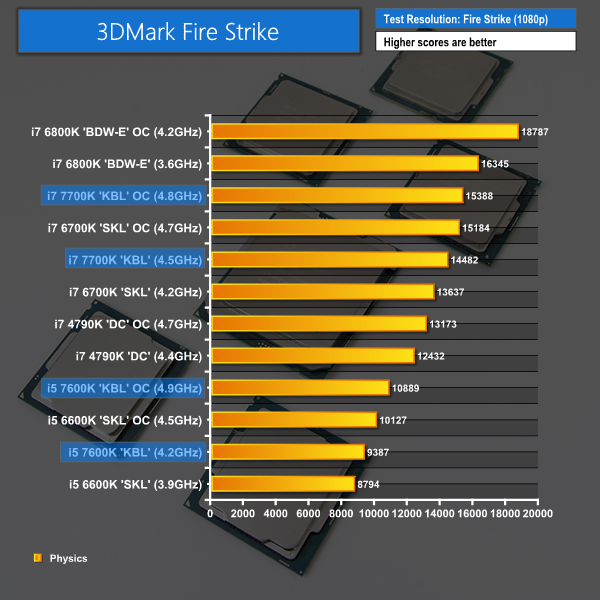
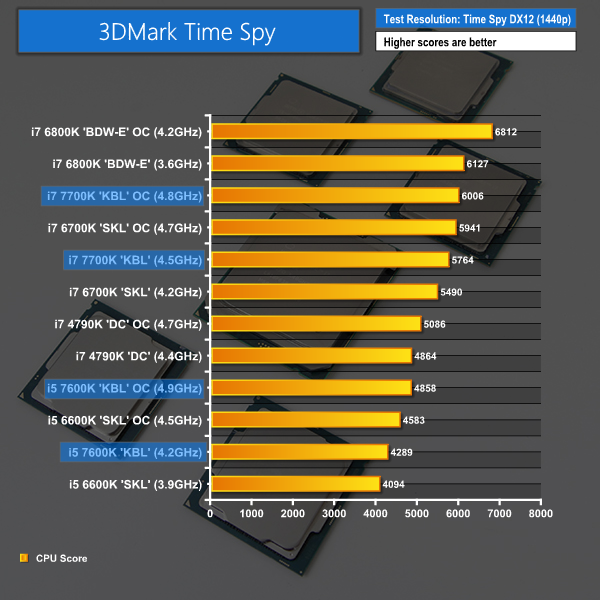
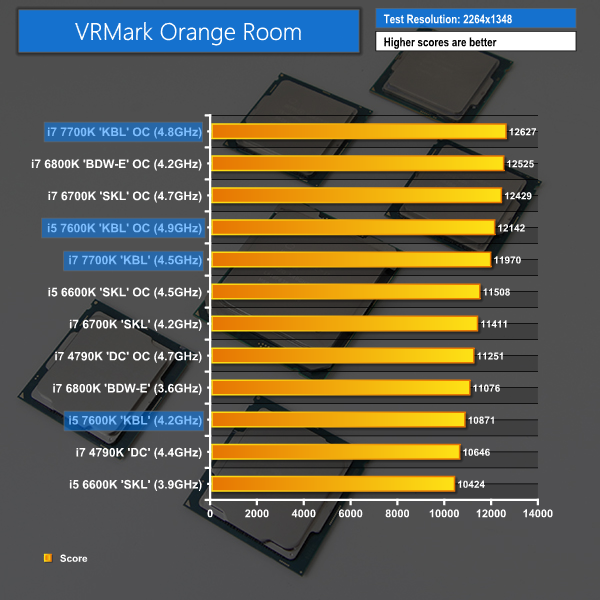
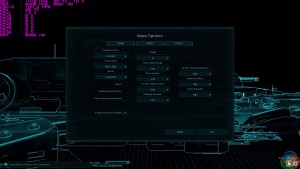
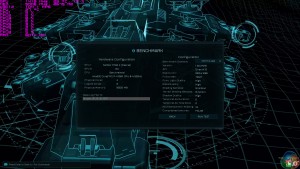
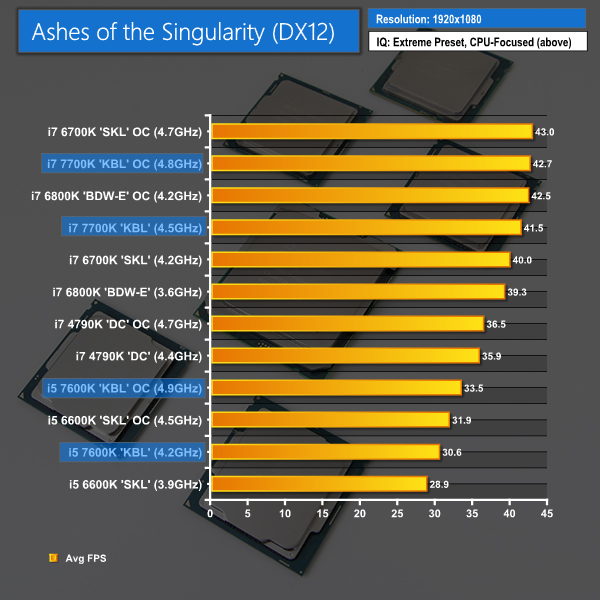

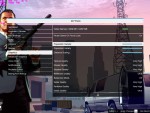
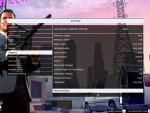

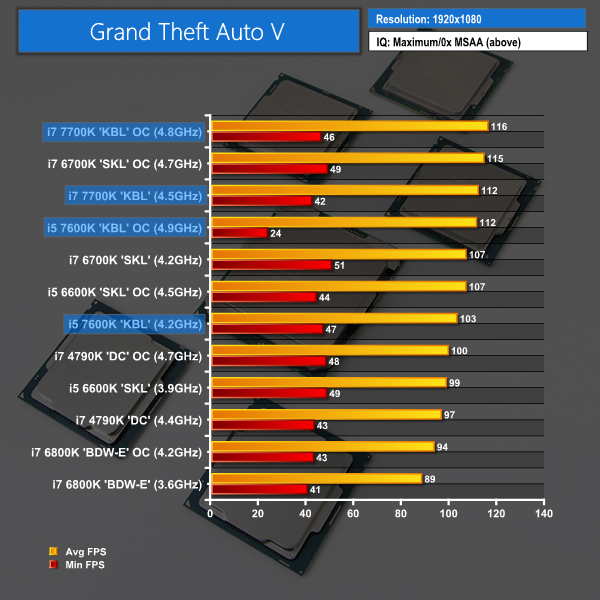
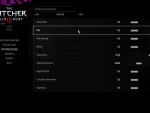
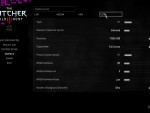
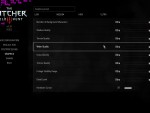
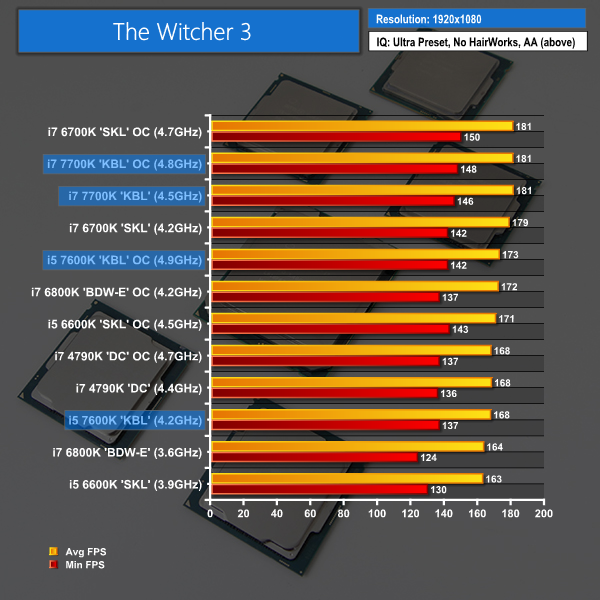
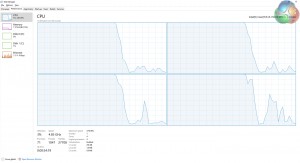

Rushed out as an answer to Zen/Ryzen. You’re stupid if you buy one of these now without seeing what AMD will offer.
No, kaby lake was announced that will be little boost from skylake, the best of intel is coming from Cannonlake
It’s barely a “little boost”. Clock for clock, benchmark results show literally 0 improvement. Only improvement is slightly better OC.
Very disappointing performance it’s almost the same with 6700k why intel bothered to release this ??
Cannonlake looks more promising
Most pointless intel release to date. The day they go back to dropping the igpu on the i5/i7 range and keep them for the i3 will be the day we actually get improvements. I would expect if they dropped a CPU with a 5.0GHz out the box speed and some decent gains whilst loosing the intergration then almost all gamers running dedicated GPU’s would take note and buy.
As it is there is zero reason to look at this and wait to see what Ryzen (release January 2017) and Cannon Lake (Late 2017) do really if you have anything in the i5/i7 4 series or above.
It may well be that Cannonlake is the answer to Ryzen, however the release of the 7700k is inline with the Ryzen release and Cannonlake will be 9-11 months later.
The though that there will be people out there who’ll upgrade from Skylake to this…..
under performing junk I will pass
Not from Cannonlake. From Ice Lake in 2019. Intel is in a bad situation right now. They have no real developments in the works until 2019. Kaby Lake up to Coffee Lake are simple increments. Kaby Lake is just a Skylake refresh with a different name, and Coffee Lake will just be Cannonlake with six cores coming to the mainstream platform; essentially, the low-tier of Cannonlake-E rebadged. Like Broadwell-E’s 6800K/6850K.
I was hoping for better I was going to finally jump from my 2600k to this gen but there is very little difference between my cpu and 6700k and it looks like there is no difference between that and this new gen.
Hey y’all, i’ve read thru your comments about the Kaby Lake 7700k and I have a request. I am FINALLY able to afford to upgrade my “gaming rig” which is an old ThinkCenter Pent Dual Core E5500 with an Nvidia GeForce GT 730, so anything will be mo betta… My question is what to buy as the heart of a new Gaming Rig? I am Network Spt specialist so I can assemble myself but im not up to date on the best gaming gear. If you could please make recommendations? I can probably spend up to $1800 that I received from my late mother’s estate. Thanks, plz dont hate, i really need your input. Peace!
Best to wait for Zen, then you can get an i7 or the equivalent AMD CPU depending on which performs better or is better value for money.
Im on the same boat buddy, tired of this deliberate turtle play from both AMD and Intel.
Thank you, since you replied I’ve watched the Zen video at https://www.youtube.com/watch?v=4DEfj2MRLtA and I am definitely going to wait for the Ryzen release. In the mean time I will research the AM4 Mobos available and try to choose one. I have long been an avid Nvidia fanatic and never once thought about using a Radeon card but I must admit I find the new AMD Vega interesting. I am looking forward to seeing the benchmarks on it and possibly purchase one for my new gaming rig.
i returned my skylake for this, it was just a few dollar more considering the return cost. I think if i wasnt in the return window though there’s no chance id spend money on upgrading.
I needed(Old one died) a new CPU that’s the only reason I got kaby lake
I like the z270’s though
http://www.dell.com/en-us/shop/productdetails/alienware-aurora-r6-desktop/dpcwxt03s?selectionState=eyJGUHJpY2UiOjE3NzkuOTksIk9DIjoiZHBjd3h0MDNzIiwiUXR5IjoxLCJNb2RzIjpbeyJJZCI6MTQ2LCJPcHRzIjpbeyJJZCI6IjcyMUpEOSIsIlByaWNlIjo0MDAuMH1dfSx7IklkIjoxMTYsIk9wdHMiOlt7IklkIjoiODUwTENPRCIsIlByaWNlIjoxNTAuMH1dfSx7IklkIjoxNiwiT3B0cyI6W3siSWQiOiJEVkRSVyIsIlByaWNlIjozMC4wfV19LHsiSWQiOjQsIk9wdHMiOlt7IklkIjoiVVNLWUJEIn1dfSx7IklkIjoxMiwiT3B0cyI6W3siSWQiOiJBTFdNU0UifV19LHsiSWQiOjU5NywiT3B0cyI6W3siSWQiOiJEVkRTVyJ9XX0seyJJZCI6NzQ5LCJPcHRzIjpbeyJJZCI6IkNJN0tCTCJ9XX1dfQ%253D%253D